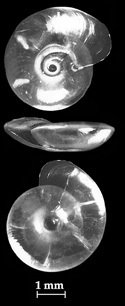Shell shaped like a small lens.
Two species of the Planorbidae may be described as approximately lens shaped.
The first is reasonably common.

Hippeutis complanatus
(Linnaeus, 1758)
Genus: HIPPEUTIS Charpentier, 1837
Only one species occurs in northern Europe.
Hippeutis complanatus(Linnaeus, 1758)
Description: The shell is very flattened, and lens-shaped. It is light horn coloured, transparent and glossy. Each whorl is bluntly angled at the periphery, and overlaps the preceding one, more obviously so on the lower surface. Both sides are equally convex. The spire is depressed and the umbilicus is wide and shallow. The aperture is lanceolate.
Size: Height: 1.5 – 2 mm. Breadth: 4 – 6 mm.
Habitat: This snail is found frequently on water weeds in ditches, ponds, canals, marshes and reservoirs, throughout most of Britain except the Highlands and Islands of Scotland, but it is not usually found in fast flowing water.

Segmentina nitida
(Müller, 1774)
The second is decidedly rare.
SEGMENTINA Fleming, 1818
Only one species of this genus occurs in northern Europe.
Segmentina nitida (Müller, 1774)
Description: This shell superficially resembles Hippeutis complanatus by being transparent, glossy and lens-shaped in cross-section. However, it is higher in proportion to its breadth, the whorls are flat above and more rounded below, and each whorl overlaps the preceding one more on the upper than on the lower side.
The most obvious difference is that in this species lamellae show through the transparent shell and are arranged in groups of three, appearing to divide the shell into separate chambers.
Size: Height: 2 mm. Breadth: 5 mm.
Habitat: This has always been a local snail occurring amongst weeds in still waters in a few southern counties of England, but it is declining throughout its range all over Europe, probably due to eutrophication of its habitat by run-off of fertilisers.
